Abstract
A blocking enzyme-linked immunosorbent assay (B-ELISA), using two neutralizing monoclonal antibodies (MAbs), was established and compared with the virus neutralization test (VNT) for detecting specific peste-des-petits-ruminants virus (PPRV) antibody in caprine and ovine sera. This technique was developed because VNT, the only available specific serological test for PPRV and the cross-reactive rinderpest virus (RPV), is time-consuming and unaffordable for most laboratories in regions where both peste des petits ruminants and rinderpest occur. The test depends on the blocking of the binding of the MAb to a specific epitope in the presence of positive serum. Test conditions were optimized by using peste-des-petits-ruminants and rinderpest sera that were known to be VNT positive and negative. A blocking format, in which serum is preincubated with a solid-phase PPRV antigen and then incubated with the MAb, yielded levels of sensitivity and specificity superior to those of a competitive format, in which the two reagents are added simultaneously. A threshold value of 45% inhibition, representing the mean for a negative population (n = 277) plus 2.7 standard deviations, was adopted for routine screening. A total of 605 serum samples were screened by B-ELISA and the VNT. The sensitivity and specificity of B-ELISA relative to the VNT were 90.4 and 98.9%, respectively. Of 264 field serum samples tested, 11 (4.2%) could not be assayed by the VNT because of contamination or cytotoxicity; the overall agreement quotient between results of the two tests (n = 253) was 0.91. A high correlation (r>/=0.98) was observed between B-ELISA and the VNT for endpoint titration of sera (n=57). Because B-ELISA proved to be nearlyas sensitive and specific as the VNT while being simpler and more rapid, it would be an adequate substitute for the VNT for assessing herd immune status and for epidemiologic surveillance.
Full text
PDF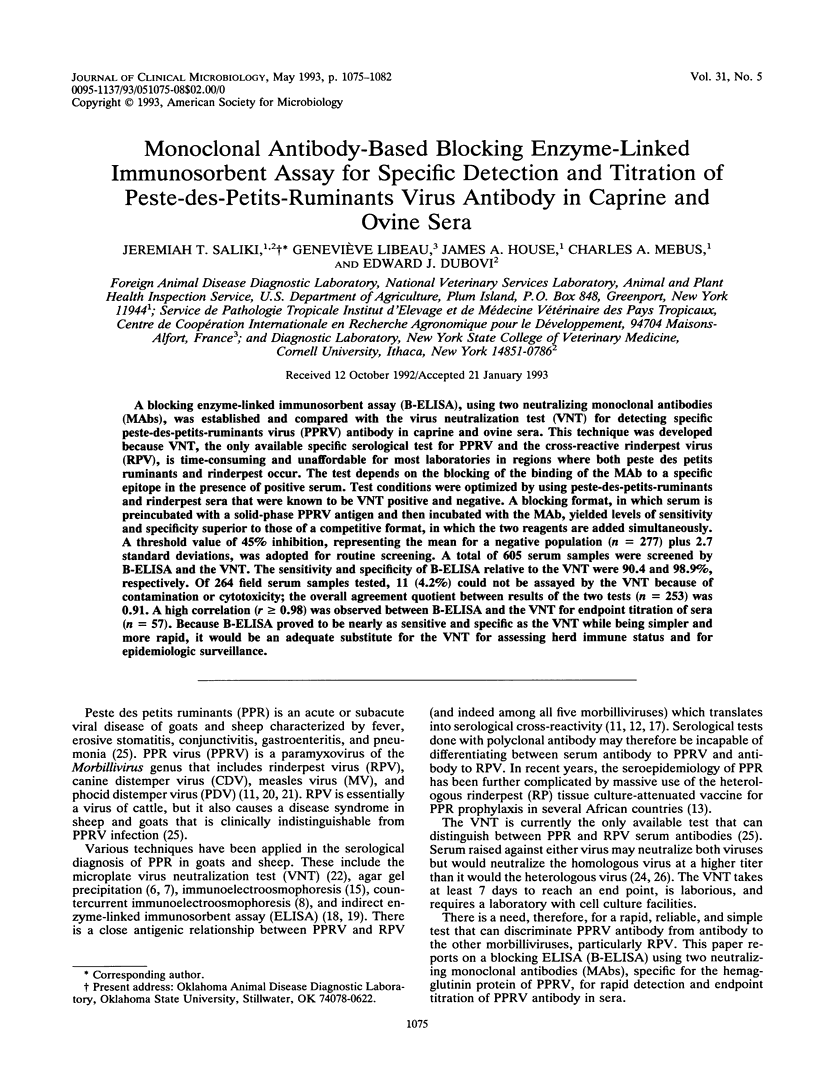
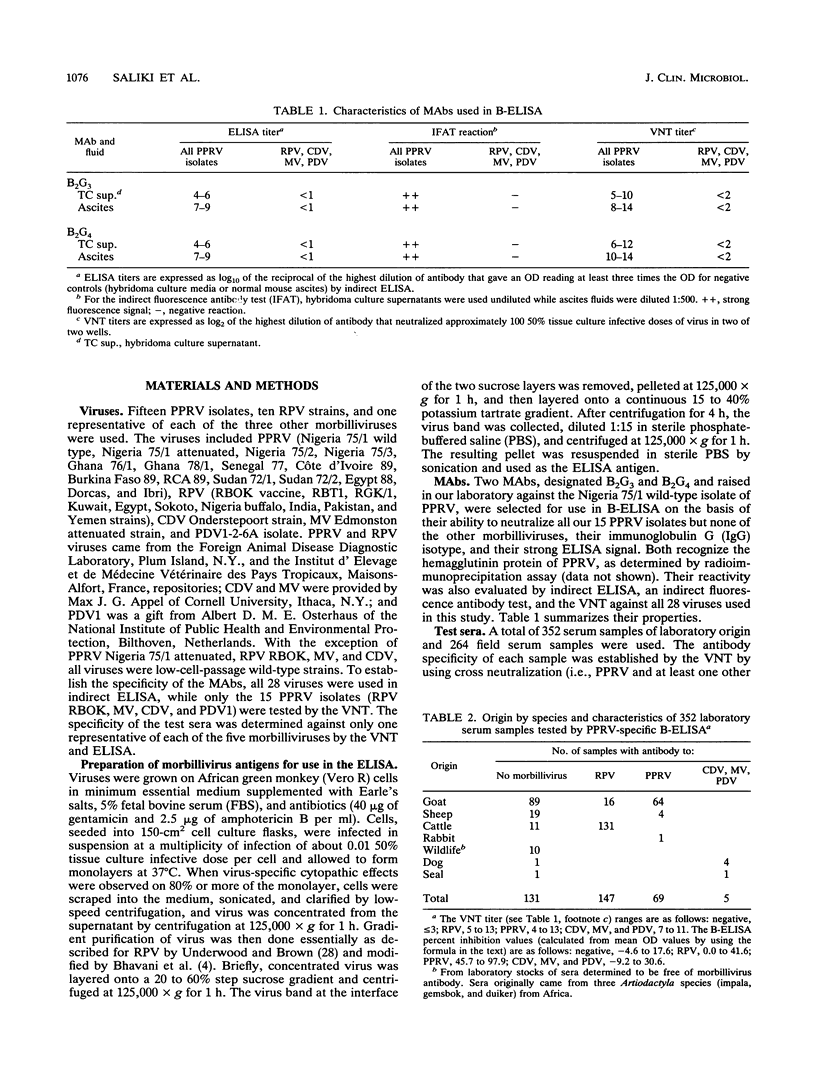
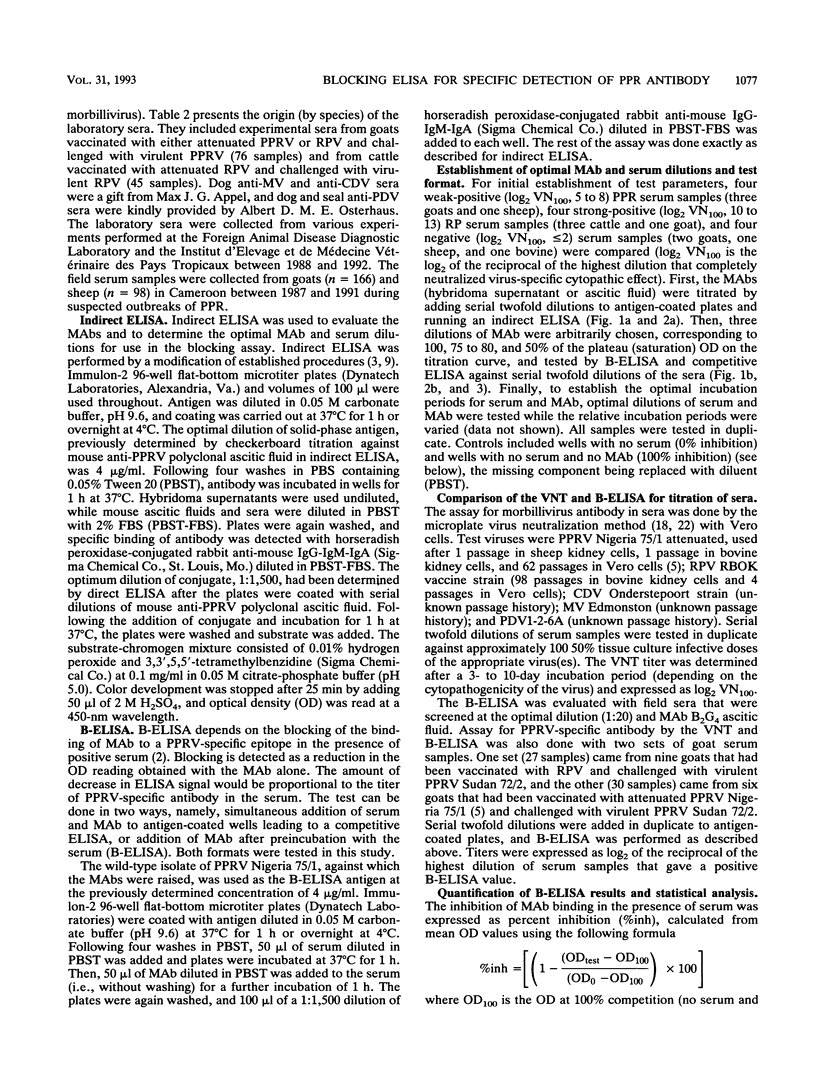
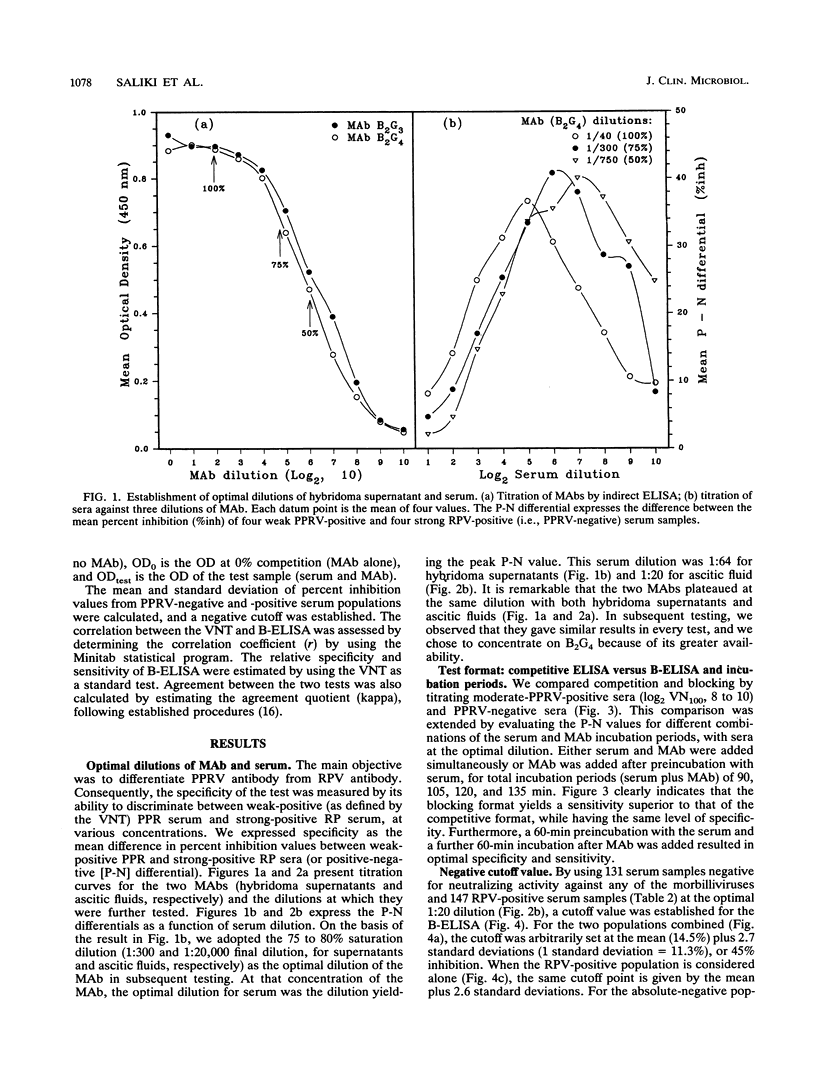
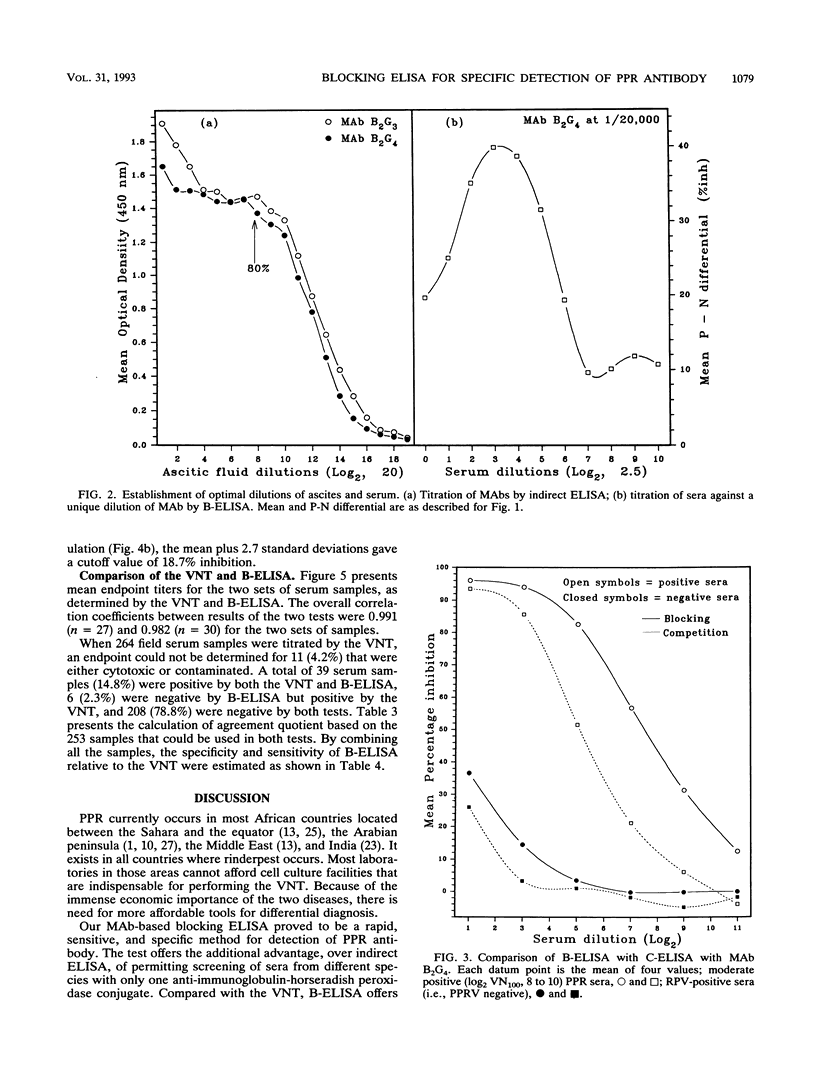
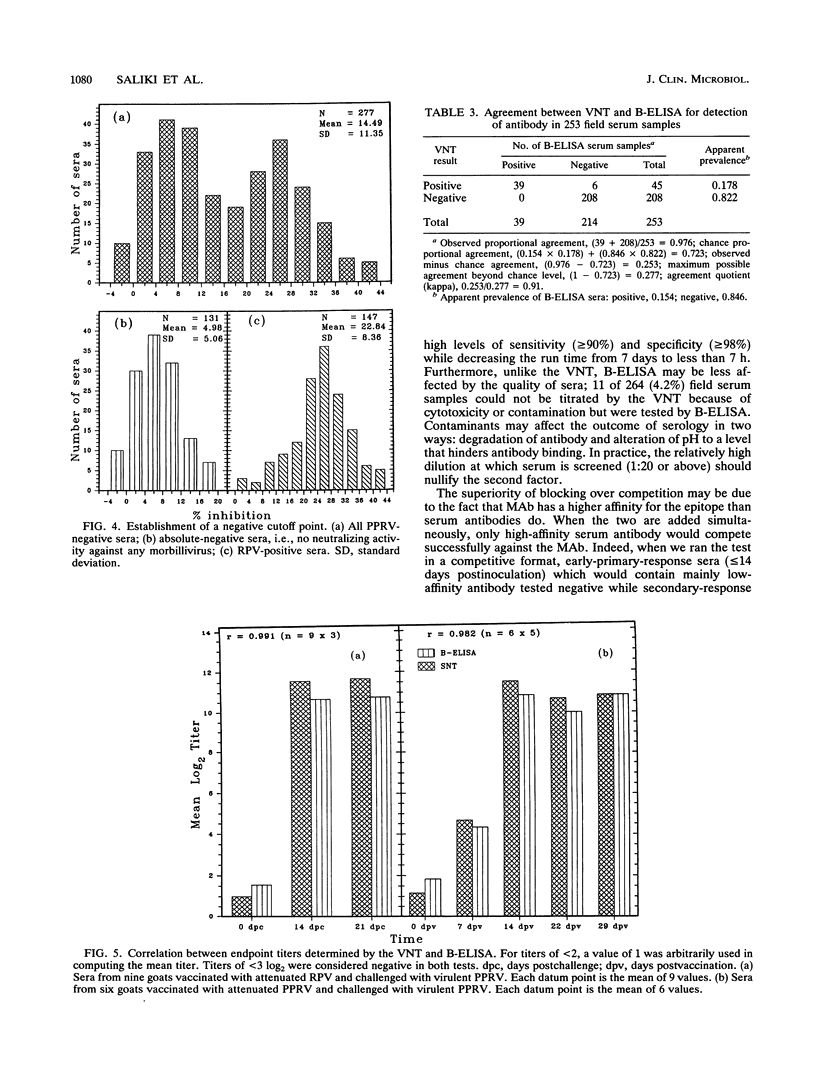
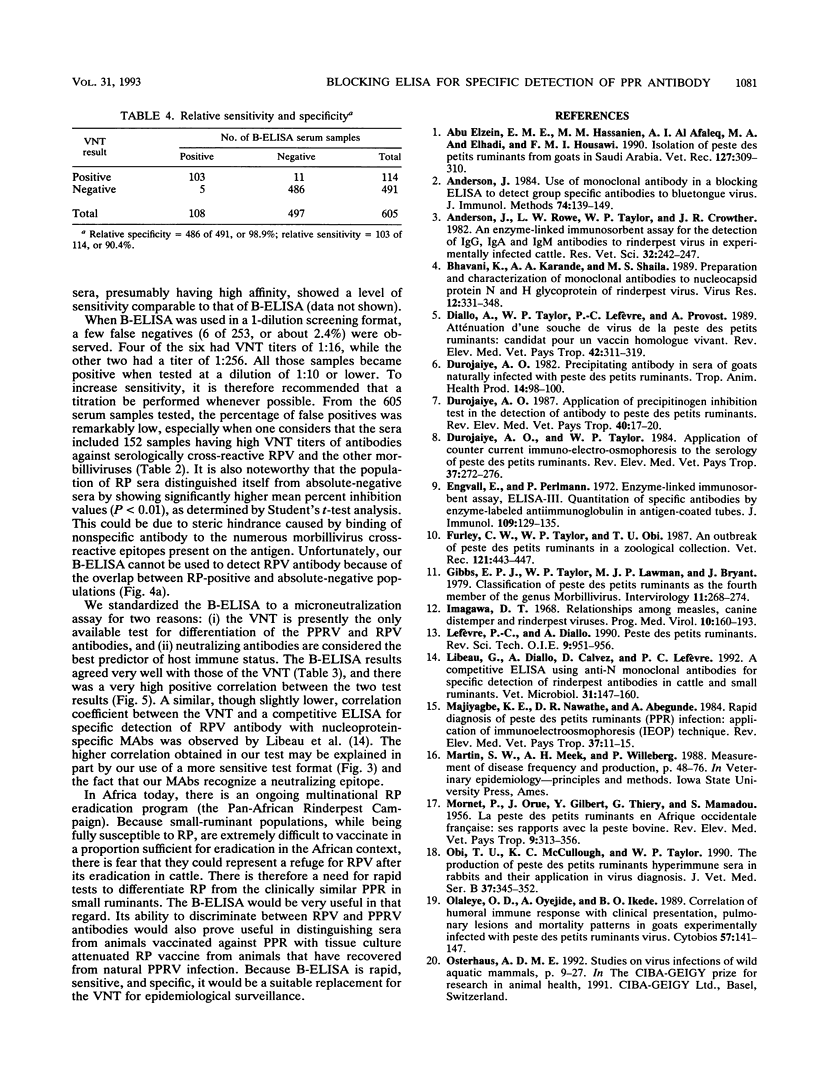

Selected References
These references are in PubMed. This may not be the complete list of references from this article.
- Abu Elzein E. M., Hassanien M. M., Al-Afaleq A. I., Abd Elhadi M. A., Housawi F. M. Isolation of peste des petits ruminants from goats in Saudi Arabia. Vet Rec. 1990 Sep 22;127(12):309–310. [PubMed] [Google Scholar]
- Anderson J., Rowe L. W., Taylor W. P., Crowther J. R. An enzyme-linked immunosorbent assay for the detection of IgG, IgA and IgM antibodies to rinderpest virus in experimentally infected cattle. Res Vet Sci. 1982 Mar;32(2):242–247. [PubMed] [Google Scholar]
- Anderson J. Use of monoclonal antibody in a blocking ELISA to detect group specific antibodies to bluetongue virus. J Immunol Methods. 1984 Nov 16;74(1):139–149. doi: 10.1016/0022-1759(84)90375-2. [DOI] [PubMed] [Google Scholar]
- Bhavani K., Karande A. A., Shaila M. S. Preparation and characterization of monoclonal antibodies to nucleocapsid protein N and H glycoprotein of rinderpest virus. Virus Res. 1989 Apr;12(4):331–348. doi: 10.1016/0168-1702(89)90091-9. [DOI] [PubMed] [Google Scholar]
- Diallo A., Taylor W. P., Lefèvre P. C., Provost A. Atténuation d'une souche de virus de la peste des petits ruminants: candidat pour un vaccin homologue vivant. Rev Elev Med Vet Pays Trop. 1989;42(3):311–319. [PubMed] [Google Scholar]
- Durojaiye O. A. Application of a precipitinogen inhibition test in the detection of antibody to peste des petits ruminants virus. Rev Elev Med Vet Pays Trop. 1987;40(1):17–20. [PubMed] [Google Scholar]
- Durojaiye O. A. Precipitating antibody in sera of goats naturally affected with peste des petits ruminants. Trop Anim Health Prod. 1982 May;14(2):98–100. doi: 10.1007/BF02282591. [DOI] [PubMed] [Google Scholar]
- Durojaiye O. A., Taylor W. P. Application of countercurrent immuno-electro-osmo-phoresis to the serology of peste des petits ruminants. Rev Elev Med Vet Pays Trop. 1984;37(3):272–276. [PubMed] [Google Scholar]
- Engvall E., Perlmann P. Enzyme-linked immunosorbent assay, Elisa. 3. Quantitation of specific antibodies by enzyme-labeled anti-immunoglobulin in antigen-coated tubes. J Immunol. 1972 Jul;109(1):129–135. [PubMed] [Google Scholar]
- Furley C. W., Taylor W. P., Obi T. U. An outbreak of peste des petits ruminants in a zoological collection. Vet Rec. 1987 Nov 7;121(19):443–447. doi: 10.1136/vr.121.19.443. [DOI] [PubMed] [Google Scholar]
- Gibbs E. P., Taylor W. P., Lawman M. J., Bryant J. Classification of peste des petits ruminants virus as the fourth member of the genus Morbillivirus. Intervirology. 1979;11(5):268–274. doi: 10.1159/000149044. [DOI] [PubMed] [Google Scholar]
- Imagawa D. T. Relationships among measles, canine distemper and rinderpest viruses. Prog Med Virol. 1968;10:160–193. [PubMed] [Google Scholar]
- Libeau G., Diallo A., Calvez D., Lefèvre P. C. A competitive ELISA using anti-N monoclonal antibodies for specific detection of rinderpest antibodies in cattle and small ruminants. Vet Microbiol. 1992 Jun 1;31(2-3):147–160. doi: 10.1016/0378-1135(92)90073-3. [DOI] [PubMed] [Google Scholar]
- Majiyagbe K. A., Nawathe D. R., Abegunde A. Rapid diagnosis of peste des petits ruminants (PPR) infection, application of immunoelectroosmophoresis (IEOP) technique. Rev Elev Med Vet Pays Trop. 1984;37(1):11–15. [PubMed] [Google Scholar]
- Obi T. U., McCullough K. C., Taylor W. P. The production of peste des petits ruminants hyperimmune sera in rabbits and their application in virus diagnosis. Zentralbl Veterinarmed B. 1990 Jul;37(5):345–352. doi: 10.1111/j.1439-0450.1990.tb01068.x. [DOI] [PubMed] [Google Scholar]
- Olaleye O. D., Oyejide A., Ikede B. O. Correlation of humoral immune response with clinical presentation, pulmonary lesions and mortality patterns of goats experimentally infected with peste des petits ruminants virus. Cytobios. 1989;57(230-231):141–147. [PubMed] [Google Scholar]
- Osterhaus A. D., Vedder E. J. Identification of virus causing recent seal deaths. Nature. 1988 Sep 1;335(6185):20–20. doi: 10.1038/335020a0. [DOI] [PubMed] [Google Scholar]
- Rossiter P. B., Jessett D. M., Taylor W. P. Microneutralisation systems for use with different strains of peste des petits ruminants virus and rinderpest virus. Trop Anim Health Prod. 1985 May;17(2):75–81. doi: 10.1007/BF02360775. [DOI] [PubMed] [Google Scholar]
- Shaila M. S., Purushothaman V., Bhavasar D., Venugopal K., Venkatesan R. A. Peste des petits ruminants of sheep in India. Vet Rec. 1989 Dec 9;125(24):602–602. [PubMed] [Google Scholar]
- Taylor W. P., Abegunde A. The isolation of peste des petits ruminants virus from Nigerian sheep and goats. Res Vet Sci. 1979 Jan;26(1):94–96. [PubMed] [Google Scholar]
- Taylor W. P. Serological studies with the virus of peste des petits ruminants in Nigeria. Res Vet Sci. 1979 Mar;26(2):236–242. [PubMed] [Google Scholar]
- Taylor W. P., al Busaidy S., Barrett T. The epidemiology of peste des petits ruminants in the Sultanate of Oman. Vet Microbiol. 1990 May;22(4):341–352. doi: 10.1016/0378-1135(90)90021-m. [DOI] [PubMed] [Google Scholar]
- Underwood B., Brown F. Physico-chemical characterisation of rinderpest virus. Med Microbiol Immunol. 1974;160(2-3):125–132. doi: 10.1007/BF02121719. [DOI] [PubMed] [Google Scholar]


